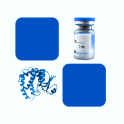
- Remove this product from my favorite's list.
- Add this product to my list of favorites.
Products
Viewed products
Newsletter
 |  |  |  |  |  |

Background
CD9 antigen also known as tetraspanin-29 (TSPAN29), 5H9 antigen, Leukocyte antigen MIC3 (MIC3), Motility-related protein, is a multi-pass membrane protein which belongs to the tetraspanin (TM4SF) family or the transmembrane 4 superfamily. CD9 is a cell surface glycoprotein that is known to complex with integrins and other transmembrane 4 superfamily proteins. TSPAN29 is found on the surface of exosomes. MIC3 Involved in platelet activation and aggregation, regulates paranodal junction formation and also Involved in cell adhesion, cell motility and tumor metastasis. CD9 antigen also seems to be a key part in the egg-sperm fusion during mammalian fertilization.
Source
Recombinant Human CD9, His Tag (CD9-H5220) is expressed from human 293 cells (HEK293). It contains AA Ser 112 - Ile 195 (Accession # P21926-1).
Predicted N-terminus: Ser 112
Molecular Characterization
This protein carries a polyhistidine tag at the C-terminus.
The protein has a calculated MW of 11.6 kDa. The protein migrates as 12 kDa under reducing (R) condition (SDS-PAGE).
Endotoxin
Less than 1.0 EU per μg by the LAL method.
Purity
>95% as determined by SDS-PAGE.
Formulation
Lyophilized from 0.22 μm filtered solution in PBS, pH7.4. Normally trehalose is added as protectant before lyophilization.
Reconstitution
See Certificate of Analysis for details of reconstitution instruction and specific concentration.
Storage
For long term storage, the product should be stored at lyophilized state at -20°C or lower.
Please avoid repeated freeze-thaw cycles.
This product is stable after storage at:
-20°C to -70°C for 12 months in lyophilized state;
-70°C for 3 months under sterile conditions after reconstitution.
(1) "CyTOF analysis revealed platelet heterogeneity in breast cancer patients received T-DM1 treatment"
Ma, Pang, Shang et al
Clin Immunol (2024)
(2) "Extracellular vesicles selective capture by peptide-functionalized hollow fiber membranes"
Salerno, Piscioneri, Morelli et al
J Colloid Interface Sci (2024) 667, 338-349
(3) "Storage of plasma-derived exosomes: evaluation of anticoagulant use and preserving temperatures"
Yang, Han, Liu et al
Platelets (2024) 35 (1), 2337255
Showing 1-3 of 2836 papers.
Follow us